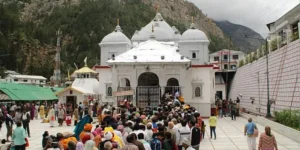Introduction
India, a land steeped in history and indian heritage, boasts a wealth of cultural treasures. That enchant and inspire visitors from around the globe. From ancient cave complexes like Ajanta to architectural marvels like the Taj Mahal and the Red Fort Complex. India’s UNESCO World Heritage Sites weave a narrative of unparalleled grandeur and significance. With each site bearing witness to centuries of human endeavor, religious devotion, and artistic mastery. India’s heritage places offer a captivating journey through time, culture, and spirituality. Join us as we embark on a fascinating exploration of India’s rich tapestry of cultural and architectural wonders.
10 indian Heritage Places
1. Ajanta Caves
The caves at Ajanta are located on a horseshoe-shaped hill in the Waghora River belt in the Indian state of Maharasthra and they are one of the oldest UNESCO World Heritage sites in India. There are thirty sculpted and painted caves in Ajanta that represent a series of works of outstanding artistic and religious significance. The first Buddhist temples in the Ajanta Caves date from the 2nd and 1st century BC, while the others date from the Gupta period (5th and 6th century AD). They contain many remarkable illustrations of Jataka, a sacred text that recounts episodes from Buddha’s life in the many incarnations he experienced on his journey to enlightenment.
The Caves were home to a community of monks from the second to the sixth century AD. Some of the caves were temples (chaitya) and others monasteries (vihara). In addition to the architectural features and sculptures that complement the paintings, the iconographic combination of paintings is also important. The refined lightness of the decorations, the balance of the composition, the beauty of the female figures place the paintings in Ajanta among the greatest achievements of the Gupta period and the post-Gupta style.
2. Taj Mahal
The Taj Mahal is an architectural masterpiece located in Agra that is a monument to determined craftsmanship and eternal love. This ivory-white marble tomb was built in the 17th century by the Mughal Emperor Shah Jahan and is a jewel in the crown of India. The striking sight of the unique dome and detailed minarets greets guests as they go closer to the building’s great entryway.
While entering the majestic gates, visitors find themselves in a realm of unparalleled richness and cultural importance. The finely tended gardens, featuring reflecting pools, intensify the dreamlike atmosphere, producing a symphony of hues and scents. The tombs of Shah Jahan and his adored wife Mumtaz Mahal are located in the central mausoleum. Their eternal resting place is a moving representation of unshakable love.
Visitors are astounded by the detailed carvings that feature geometric designs, floral themes, and Quranic inscriptions as they go between the spotless white marble structures. The dynamic interplay of shadows created by the light’s play on the marble surfaces enhances the visual appeal. The Taj Mahal is more beautiful when viewed at sunrise or dusk when it is bathed in a warm, golden glow.
Besides being a UNESCO World Heritage Site, the Taj Mahal is a live example of the magnificence of Mughal architecture and an enduring symbol of love that draws tourists from all over the world.
3. Fatehpur Sikri
Fatehpur Sikri is a silent reminder of a period of royal luxury and architectural genius in Agra’s outskirts. This UNESCO World Heritage Site was built with great care and was the capital of the Mughal Empire for a short but important time, having been commissioned by the Mughal Emperor Akbar in the 16th century.
When visitors approach the Buland Darwaza, the massive entryway to the city, they are immediately taken aback by the massive red sandstone monument honoring Akbar’s successful conquest of Gujarat. This feat of architecture serves as a fitting introduction to the magnificence that lies beyond the gates of Fatehpur Sikri.
Visitors can sense the spiritual resonance that penetrates the air as they pass by the tomb of Salim Chishti, a famed Sufi saint, and Jama Masjid, one of the largest mosques in India. Standing at a height of 54 meters, the Buland Darwaza is a remarkable example of architectural design that defies time as well as a symbol of military victory.
The abandoned red sandstone buildings of Fatehpur Sikri offer a moving window into Mughal history while echoing stories of a once-thriving royal capital. Its palaces, courtyards, and religious buildings tell a tale of ambition, conquest, and the fleeting nature of power, making it a must-visit location for both history lovers and curious tourists.
Must Read: 5 Best Historical Places in Gujarat
4. Qutub Minar
The Qutub Minar is a towering monument to the architectural skills of ancient India that stands tall in the center of Delhi. Constructed in the early 13th century, this UNESCO World Heritage Site is a famous representation of the rich ancestral legacy of the Delhi Sultanate.
The striking 73-meter-tall red sandstone tower is the first thing that draws notice to the Qutub Minar complex as it approaches. The tale of the minaret’s construction by Qutb-ud-din Aibak and subsequent monarchs, such as Iltutmish and Firoz Shah Tughlaq, is narrated through the elaborate carvings and inscriptions on its surface. The Qutub Minar is a remarkable example of Indo-Islamic architecture with its unique fluted style.
The Quwwat-ul-Islam Mosque, the first mosque constructed in Delhi, is located next to the Minar and has architectural features that combine Islamic and Hindu styles. The courtyard’s Iron Pillar, which has withstood centuries of weather and corrosion, is a source of fascination for both scientists and historians.
As one moves through the complex, one comes onto the Alai Darwaza, a striking entrance that exemplifies the Sultanate’s combination of Indian and Persian architectural forms. The walls’ elaborate geometric patterns and calligraphic artwork highlight the time’s artistic expertise.
Surrounded by rich nature, the Qutub Minar complex offers a peaceful shelter from the busy daily life. By exploring its numerous buildings, one can take a trip through time and learn about the layers of Delhi’s past and the blending of cultures that built the area. A visit to the Qutub Minar offers visitors an immersive sense of the grandeur of medieval Delhi, inspiring them with the ongoing legacy of India’s architectural heritage.
5. Red Fort Complex
The Red Fort Complex is located in the city of Agra in the Indian state of Uttar Pradesh, located 2.5 kilometers away from the Taj Mahal. The outstanding fort is made out of strong red sandstone and encompasses the entire Old City, which was the capital of the Mughal Empire in the 16th century. Most of the fort was built during the reign of Emperor Akbar when he declared Agra his capital, and it took on its present appearance during the time of Akbar’s grandson Shahan Jahan who built the Taj Mahal for his wife at the time. It was built for eight years and was completed in 1573.
The fort holds an area of more than 380,000 m2 and it was built of red sandstone. Like the fortress in Delhi, this fortress is one of the most representative symbols of the Mughal Empire. Apart from Mughal architecture and planning, a fusion of Timurid, Hindu, and Persian tradition, there are also structures dating from the British period and their military use of the forts. The fort was designated a UNESCO World Heritage site in 2007. Today it is partially used as a tourist attraction while the other part is used for military purposes.
6. Jantar Mantar
Among known materials and philosophical contributions of India, there is Jantar Mantar. An astronomical observation site built in the early 18th century in Jaipur. This astronomical observatory and UNESCO World Heritage site is one of the five observatories built. In west-central India by Maharajah Sawaii Jai Singh II, the ruler of the kingdom of Amber. Passionately interested in mathematics and astronomy, he incorporated elements from early Greek and Persian observatories into his designs. There are about 20 main instruments designed for the observation of astronomical positions. That represent one of the most significant and best-preserved historic observatories in India. This heritage site also shows fascinating astronomical skills and cosmological concepts of the court. Of Maharajah Sawaii Jai Singh II of Jaipur from the end of the Mughal period.
7. Sun Temple at Konârak
The Sun Temple at Konârak, also know as the Black Pagoda, is a Hindu temple built during the kingdom of Orissa from 1238 to 1250 in Konârak, a place in the Indian state of Odisha, on the east coast of India. It was built during the reign of King Narasingha Deva (1238-1264). The temple represents the chariot of the sun god Surya, who, according to Hindu mythology, travels through the sky in a chariot drawn by seven horses.
On the north and south sides there are 24 wheels 3 meters in diameter with engraved symbolic motifs which. Together with the number of horses, refer to the seasons, months, and days of the week. The entire temple is align along the path of the sun across the sky. In an east-west direction, and divided into various organized spatial units. The harmonious integration of architecture with the decorative reliefs of naturally carved. Animal and human figures makes it a unique temple in Odisha and one of the cultural heritage sites in India. According to the Ministry of New and Renewable Energy Konark will run on solar energy in the coming times. The innovative scheme is in line with the Government’s vision to transform the ancient. Sun Temple in Odisha and the historic Konark Town into Surya Nagri (solar city).
8. Western Ghats
The Western Ghats is a magnificent mountain range that stretches across western India and is recogniz. As a UNESCO World Legacy Site. It is home to a diverse range of wildlife, unusual ecosystems, and cultural legacy. This vast mountain range crosses several states, including Goa, Kerala, Karnataka, Maharashtra, and Tamil Nadu.
When traveling through the Western Ghats, the scenery opens up into an amazing view of mist-covered peaks. Gushing waterfalls, and lush woods. The Ghats are home to many endemic species and are a shelter for a broad range of flora and fauna. Making them one of the eight “hottest hotspots” of biological variety in the world.
The many temples, ancient forts, and native communities. Who call the Western Ghats home attest to the mountain range’s cultural significance. The Ghats are the source of several significant rivers. Which support a wide variety of livelihoods and increase the agricultural fertility of the plains around them.
Traveling through the Western Ghats is more than just a physical examination of a mountain range. It is an enticing experience that reveals the UNESCO World Heritage Site’s ecological subtleties. Cultural diversity, and beautiful delights. Adventurers, nature lovers, and cultural explorers are invit. By the Western Ghats to fully experience the significance and beauty of this ancient mountain range. Which is still the source of life and a storehouse of natural and cultural riches.
9. Group of Monuments at Hampi
Hampi is a village located in the Indian state of Karnataka. From the 14th to the 16th century, Hampi was the capital of the Vijayanagar Empire and a center of religion. Trade, and culture which makes it one of the greatest heritage sites in India. After the Muslim conquest in 1565, Hampi was looted, partly destroy, and abandon. But some of its great architectural achievements are still preserv. In addition to temples and shrines, a complex of public buildings (forts, royal architecture, pillared halls, memorial structures, stables, water structures, etc). Was also includ in the massively fortifi capital that indicates a highly evolv and multi-ethnic society. Fascinating details about Hampi landscape are certainly seen in the boulders. That were once part of gigantic granite monoliths. The monuments in Hampi are consider to be the original Hindu architecture of southern India. But with strong influences of Islamic architecture from the north.
The Archaeological Society of India is still conducting excavations in the area, regularly discovering new objects and temples. While I visit the site in 2017 the authorities decid to finally put control on the informal tourism sector. Which also result in a significant number of residents being evict. Today, sand mining, road work, increased vehicular traffic, illegal constructions, and floods threaten the archeological sites.
10. Mahabodhi Temple Complex at Bodh Gaya
One of the holiest sites related to the life of Lord Buddha. The place he attain Enlightenment, is the Mahabodhi Temple Complex at Bodh Gaya in Bihar. The temple was first built by Mauryan emperor Ashoka in the 3rd century. BC while the present temple dates from the 5th and 6th century AD. The temple is mostly made of bricks cover with stucco and is one of the oldest brick temples in India. Apart from the temple, the complex includes the vajrasana or diamond throne of Buddha. The sacred Bodhi tree, Lotus Pond or the meditation garden. And other sacred sites surround by ancient votive stupas and shrines.
Although Bodh Gaya is a small village, it has temples and monasteries from other nations. That have a Buddhist tradition like Japan, Thailand, Tibet, Sri Lanka, Bangladesh, etc. The Mahabodhi Temple Complex at Bodh Gaya, one of the most important heritage sites of India. Today stands as one of the holiest places of Buddhist pilgrimage.
Also Read: tulsishyam
Conclusion
India boasts a rich tapestry of cultural and architectural marvels. Each narrating a unique story of history, religion, and human endeavor. From the ancient caves of Ajanta, bearing witness to the evolution of Buddhist art, to the timeless symbol of love. The Taj Mahal, India’s UNESCO World Heritage Sites captivate visitors with their grandeur and significance. The architectural genius displayed in Fatehpur Sikri and the Qutub Minar stands as a testament to India’s diverse cultural heritage.
Meanwhile, the Red Fort Complex and Jantar Mantar offer glimpses into India’s imperial past and scientific achievements, respectively. The Sun Temple at Konârak and the Mahabodhi Temple Complex at Bodh Gaya provide spiritual sanctuaries. While the Western Ghats and the Group of Monuments at Hampi showcase India’s natural and architectural wonders. Together, these sites offer a journey through time, culture, and spirituality. Inviting travelers to immerse themselves in the beauty and heritage of this vibrant nation.




